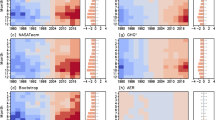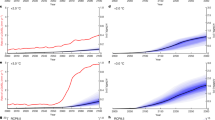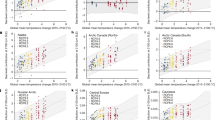Abstract
Under the Paris Agreement, emissions scenarios are pursued that would stabilize the global mean temperature at 1.5–2.0 °C above pre-industrial levels, but current emission reduction policies are expected to limit warming by 2100 to approximately 3.0 °C. Whether such emissions scenarios would prevent a summer sea-ice-free Arctic is unknown. Here we employ stabilized warming simulations with an Earth System Model to obtain sea-ice projections under stabilized global warming, and correct biases in mean sea-ice coverage by constraining with observations. Although there is some sensitivity to details in the constraining method, the observationally constrained projections suggest that the benefits of going from 2.0 °C to 1.5 °C stabilized warming are substantial; an eightfold decrease in the frequency of ice-free conditions is expected, from once in every five to once in every forty years. Under 3.0 °C global mean warming, however, permanent summer ice-free conditions are likely, which emphasizes the need for nations to increase their commitments to the Paris Agreement.
This is a preview of subscription content, access via your institution
Access options
Access Nature and 54 other Nature Portfolio journals
Get Nature+, our best-value online-access subscription
$29.99 / 30 days
cancel any time
Subscribe to this journal
Receive 12 print issues and online access
$209.00 per year
only $17.42 per issue
Buy this article
- Purchase on Springer Link
- Instant access to full article PDF
Prices may be subject to local taxes which are calculated during checkout





Similar content being viewed by others
References
Cohen, J. et al. Recent Arctic amplification and extreme mid-latitude weather. Nat. Geosci. 7, 627–637 (2014).
IPCC Climate Change 2013: The Physical Science Basis (eds Stocker, T.F. et al.) (Cambridge Univ. Press, 2013).
Adoption of the Paris Agreement FCCC/CP/2015/L.9/Rev.1 (UNFCCC, 2015).
Rogelj, J. et al. Paris Agreement climate proposals need boost to keep warming well below 2 °C. Nat. Clim. Change 534, 631–639 (2016).
Mitchell, D. et al. Realizing the impacts of a 1.5 °C warmer world. Nat. Clim. Change 6, 735–737 (2016).
James, R., Washington, R., Schleussner, C. F., Rogelj, J. & Conway, D. Characterizing half-a-degree difference: a review of methods for identifying regional climate responses to global warming targets. WIRES Clim. Change 8, e457 (2017).
Screen, J. A. & Williamson, D. Ice-free Arctic at 1.5 °C? Nat. Clim. Change 7, 230–231 (2017).
Sanderson, B. M. Community Climate Simulations to assess avoided impacts in 1.5 °C and 2 °C futures. Earth Syst. Dynam. 8, 827–847 (2017).
Wang, M. & Overland, J. E. A sea ice free summer Arctic within 30 years? Geophys. Res. Lett. 36, L07502 (2009).
Laliberté, F., Howell, S. E. L. & Kushner, P. J. Regional variability of a projected sea ice-free Arctic during the summer months. Geophys. Res. Lett. 43, 256–263 (2016).
Sigmond, M. & Fyfe, J. C. Tropical Pacific impacts on cooling North American winters. Nat. Clim. Change 6, 970–975.
Gillett, N. P., Arora, V. K., Zickfeld, K., Marshall, S. J. & Merryfield, W. J. Ongoing climate change following a complete cessation of carbon dioxide emissions. Nat. Geosci. 4, 83–87 (2011).
Swart, N. C., Fyfe, J. C., Hawkins, E., Kay, J. E. & Jahn, A. Influence of internal variability on Arctic sea-ice trends. Nat. Clim. Change 5, 86–89 (2015).
Massonnet, F. et al. Constraining projections of summer Arctic sea ice. Cryosphere 6, 1383–1394 (2012).
Fetterer, F., Knowles, K., Meier, W. & Savoie, M. Sea Ice Index (National Snow and Ice Data Center, Boulder, CO).
Rogelj, J., Schleussner, C. F. & Hare, W. Getting it right matters: temperature goal interpretations in geoscience research. Geophys. Res. Lett. 44, 10662–10665 (2017).
Mahlstein, I. & Knutti, R. September Arctic sea ice predicted to disappear near 2 °C global warming above present. J. Geophys. Res. Atmos. 117, D06104 (2012).
Rosenblum, E. & Eisenman, I. Sea ice trends in climate models only accurate in runs with biased global warming. J. Clim. 30, 6265–6278 (2017).
Notz, D. & Stroeve, J. Observed Arctic sea-ice loss directly follows anthropogenic CO2 emission. Science 354, 747–750 (2016).
Arora, V. K. et al. Carbon emission limits required to satisfy future representative concentration pathways of greenhouse gases. Geophys. Res. Lett. 38, L05805 (2011).
Meinshausen, M. et al. The RCP greenhouse gas concentrations and their extensions from 1765 to 2300. Climatic Change 109, 213–241 (2011).
Acknowledgements
We acknowledge the Canadian Sea Ice and Snow Evolution Network for proposing the CanESM2 Large Ensemble simulations and the modelling groups, the Program for Climate Model Diagnosis and Intercomparison, and the WCRP Working Group on Coupled Modelling for their roles in making available the WCRP CMIP5 multimodel data set. We thank W. Lee and Y. Jiao for technical assistance and B. Merryfield and S. Howell for their helpful comments on an earlier draft.
Author information
Authors and Affiliations
Contributions
M.S. conceived the project, designed the experiments, performed the analysis and wrote the manuscript. J.C.F. helped with the analysis and helped write the manuscript. N.C.S. helped design the experiments and edited the manuscript.
Corresponding author
Ethics declarations
Competing interests
The authors declare no competing interests.
Additional information
Publisher’s note: Springer Nature remains neutral with regard to jurisdictional claims in published maps and institutional affiliations.
Rights and permissions
About this article
Cite this article
Sigmond, M., Fyfe, J.C. & Swart, N.C. Ice-free Arctic projections under the Paris Agreement. Nature Clim Change 8, 404–408 (2018). https://doi.org/10.1038/s41558-018-0124-y
Received:
Accepted:
Published:
Issue Date:
DOI: https://doi.org/10.1038/s41558-018-0124-y
This article is cited by
-
Projections of an ice-free Arctic Ocean
Nature Reviews Earth & Environment (2024)
-
Impact of Arctic sea ice on the boreal summer intraseasonal oscillation
Climate Dynamics (2024)
-
A frequent ice-free Arctic is likely to occur before the mid-21st century
npj Climate and Atmospheric Science (2023)
-
Atmospheric circulation-constrained model sensitivity recalibrates Arctic climate projections
Nature Climate Change (2023)
-
Dominant role of early winter Barents–Kara sea ice extent anomalies in subsequent atmospheric circulation changes in CMIP6 models
Climate Dynamics (2023)



